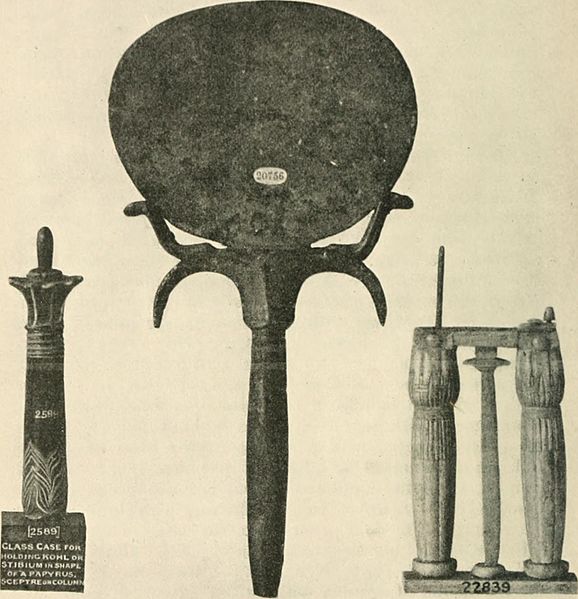
Fake ancient Egyptian antiques are still bought and sold today, just as they were back in the early 1900s. I even own a few because I love to collect fake antiques. They are all amazingly well made and make for beautiful decorations.

Antiques Made To Order
How Egyptian Mummies, Ancient Pottery and Jewelry and Art Objects Are Forged and Faked
THE fabrication of forged antiquities has become one of the most profitable industries of modern Egypt. Every year more and more wealthy American and European tourists go to the sunny and salubrious land of the Pharaohs.
Practically every one of these tourists wishes to take away some relic of the ancient Pharaohs as a souvenir. To supply this demand the modern Egyptians are working night and day making very attractive articles in the ancient style.
The Egyptian law now requires that every person finding antiquities shall report the fact to the government, which reserves the right to purchase them. This law really favors the antiquity forgers, for they represent to their customers that they are offering them contraband goods, which offer usually has the effect of whetting the appetite to buy.
A scholar and Egyptologist, Dr. T.G. Wakening, has made a lifelong study of the methods of the antiquity forgers and published a very interesting book on the subject. It is illustrated with remarkable specimens of forgeries which the author has collected himself.
The manufacture of mummy cases of all periods is one of the most profitable occupations of the antiquity forgers. A handsome mummy case will sell for $5,000 or even more, and the original cost need not be more than $20. One transaction of this kind will support a thrifty Egyptian for life.
In making the mummy case a fragment of genuine old case is frequently used so that the workers may keep the style and tone perfectly. A bundle of rags and cow bones may be used in place of the mummy, or if it is intended to make a very fine job a genuine old mummy may be inserted. Unidentified old mummies are cheap and common in Egypt.
The painted mummy cloth is counterfeited with great care. Sometimes genuine old cloth from a mummy of small value is used, as in the example shown here. The painting is modern, and an expert can tell this because the colors have run. A genuine ancient painting follows the design with greater exactness.
One of the most enterprising antiquity dealers in Egypt, a leading citizen of Luxor, actually constructed a great tomb in order to pass off his forgeries more successfully. He represented it as the tomb of some forgotten pharaoh or chief minister of three thousand years ago. He filled it with stelae, ushebti, jewelry, mummies, vases and other forged antiquities, all apparently covered with the dust of ages.
An American millionaire enjoyed the privilege of first visiting this tomb. He was conducted there secretly at dead of night in order to avoid the government guards who constantly watch the antiquities of this district. He was so impressed by what he saw that he cheerfully gave up $100,000 for the contents of the tomb. It has been filled up again several times since then.
Purchasers of antiquities are tempted by the fact that the objects are sometimes worth what is asked for them, even though forged. Dr. Wakeling mentions the case of forged antiquities of real gold that were sold for no more than the value of the metal. The modern workmanship was excellent.
Tourists will gratify their secret longing to buy antiquities in obscure places in spite of the warnings of archaeologists and reputable dealers. An American woman showed the author a handsome necklace of yellow beads, which she had bought for $50. He remarked that they were being made regularly for $2 a piece.

“How can you say so, doctor,” exclaimed the woman. “My donkey boy told me that he stole it from an old tomb himself, and he has such an honest little face!”
Scarabs furnish the greatest employment to the antiquity makers and dealers. Some of the best scarabs are made in Europe and exported to Egypt where the intelligent natives sell them to foreigners. Scarab making has been carried on for about a hundred years. It has reached such a point that learned Egyptologists are frequently unable to tell whether a specimen is genuine or not.
The scarab, which represents the sacred beetle of Egypt, was used as a charm and buried in large numbers on a mummy’s breast. It was supposed that the sacred beetle would ward off the attacks of evil spirits.
The forged scarabs are sometimes made of glass, stained to imitate some semi precious stone such as carnelian, which was much used in the ancient specimens. In another the ancient glaze is imitated of antiquity. A capable expert can detect these two forms of forgery.
Source: The Times Dispatch. Newspaper. April 20, 1913.

